1.1 What needs are addressed in the Playbook?
As described in the Introduction, we wanted to write a book for all those interested in innovation, for movers and shakers as well as entrepreneurs who design digital and physical products, services, business models, and business ecosystems as part of their work. Regarding our three personas, we were able to identify three very different kinds of users who apply design thinking in their day-to-day activities. One thing the three have in common, though: All three of them want to create something new in a rapidly changing world.
Which brings us straight to our initial question:
In the individual chapters, we focus on the three personas of “Peter,” “Lilly,” and “Marc.” We hope this lets us address the needs of design thinking practitioners as best as possible.

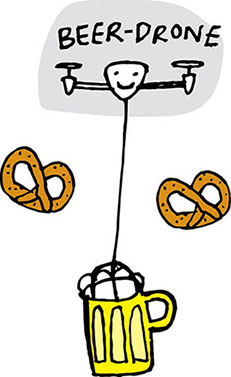

More about Peter: What is his background experience?
Peter studied at the Technical University of Munich. After graduating, he held various positions in the telecommunications, IT, media, and entertainment industries. Five years ago, he decided to move from Munich to Switzerland. Its location and excellent infrastructure convinced him to make this daring change. There, Peter met his future wife, Priya. He has been happily married for two years. She works for Google at their corporate campus in Zurich. Priya is not allowed to talk much about the exciting topics she works on, although Peter would be quite intrigued by them.
Both like to get involved with new technologies. Be it the smart watch, augmented reality, or using what the sharing economy has to offer, they try out everything the digital world comes out with. A few weeks ago, Peter had his dream of getting a Tesla come true. Now he is waiting for his car to be self-driving soon so he can enjoy the beautiful landscape while looking out the window. In his new role as Innovation & Co-Creation Manager, Peter now belongs among the “creative” ones. He has replaced his suits and leather shoes with Chucks.
Peter tried to resolve the last crisis in his relationship with a little design thinking session. Priya was very aloof with Peter all of a sudden. Peter took the time to listen to Priya and better understand her needs. Together, they discussed ways to bring more oomph into their relationship. During the brainstorming, Peter had the idea that wearing his lucky red underwear might save the relationship. But in the meantime, he had developed so much empathy for Priya’s concerns that he quickly dismissed the idea. In the end, they came up with a couple of good ideas for their relationship. Priya did wish, though, that Peter would use a different method to learn his needs besides design thinking.

Up to now, Peter had used design thinking in various situations. He learned that the approach sometimes worked very well for reaching a goal, but that sometimes it wasn’t right. He would like to get a couple of tips from experienced design thinkers to shape his work even more effectively.

Visualization of the persona
User profile of an experienced design thinker from actual practice:

Pains:
- Peter’s employer does not invest much in the further training of employees.
- Although Peter feels quite competent by now in dealing with design thinking, he is still convinced he could get more out of the approach.
- Peter has noted that, while design thinking is a powerful tool, it is not always used optimally.
- Peter frequently wonders how the digital transformation might be accelerated and what design criteria will be needed in the future to be a success on the market.
- Peter would like to combine other methods and tools with design thinking.
- Peter is faced with the challenge of having to impart to his team a new mindset.
- He would like to exchange ideas with other design thinking experts outside his company.
Gains:
- Peter has a lot of leeway in his daily work to try out new methods and tools.
- He loves books and all tangible things. He likes to use visualizations and simple prototypes for explaining things.
- What he would really like to do is establish design thinking in the whole company.
- He knows various management approaches he would like to link with design thinking.
Jobs-to-be-done:
- Peter has internalized the design thinking mindset., but sometimes, good examples that would help to change his environment don’t come easily to him.
- Peter enjoys trying out new things. With his engineering background, he is open to other approaches to problem solving (whether quantitative or analytical).
- He would like to become an expert in this environment as well. He is looking to connect with like-minded individuals.
- Peter experiments with design thinking.
More about Lilly: What is her background experience?
Lilly has great in-depth theoretical knowledge of various methods and approaches and is able to apply them practically with her teams of students. She is good at coaching these teams but lacks understanding of actual practice. Lilly offers design thinking workshops at the Center of Entrepreneurship at Singapore University of Technology & Design. Frequently, people from industrial enterprises who want to learn more in terms of their innovation capability or better understand the topic of “intrapreneurship” take part in these workshops.

Lilly lives in Singapore and shares an apartment with her friend Jonny, whom she met during her year in France. Jonny is an expat who works for a major French bank in Singapore. At first, Jonny thought Lilly’s flip-flops were somewhat freaky but, at this point, he likes that little splash of color on her.
To maximize success, Jonny sees great potential in user-centered design and his bank’s pronounced orientation toward customer interaction points. He is enormously interested in new technologies. The thought of what they might mean for banks fascinates and unsettles him at the same time. He follows events in the fintech sector very closely and has identified new potentials that might result from a systematic application of blockchain. He wonders whether such disruptive new technologies will change banks and their business models even more fundamentally than Uber changed the taxi sector or Airbnb the hotel industry—and, if so, when such changes will take place. The core question for Jonny is whether a time will come when banks as we know them will cease to exist altogether. Either way, banks need to become more customer-oriented and make better use of the opportunities that digitization offers than potential newcomers. Jonny is not afraid of losing his job as yet. But still, a start-up together with Lilly might be an exciting alternative. Jonny would like to see his bank apply design thinking and internalize a new mindset, but this is nothing but wishful thinking thus far.
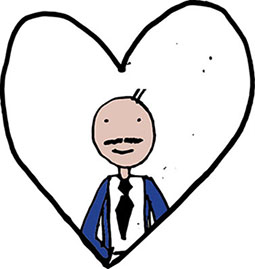
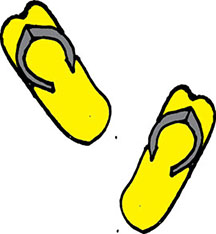

Lilly and Jonny would also like to set up a consulting firm that applies design thinking to support enterprises with digital transformation. They are still looking for something unique that their start-up could offer in comparison to conventional consultancy firms. In particular, they would like to address cultural needs in their approach to consulting. Lilly has observed too many times how the European and American design thinking mindset failed in an Asian context. She wants to integrate local particularities in her design thinking approach: the attitude of an anthropologist, the acceptance of copying competitors, and the penchant for marketing services more quickly, instead of observing the market for a long time. Something else makes them hesitant to implement their plan: They are bit risk averse because next year, once Lilly has completed her doctoral thesis, they want to get married and raise a family. Lilly wants three children.
In her free time, Lilly is active and creative. She often meets with like-minded people she knows from the SkillsFuture program, which is a national program that provides Singaporeans the possibility to develop their fullest potential throughout life, regardless of their starting points; or from events such as “Innovation by Design,” which was funded by the DesignSingapore Council. They develop concepts for, among other things, adapting the space and the environment of the country to the needs of people. Lilly is especially intrigued by digital initiatives and hackathons that come into being through real-time data from sensors, social media, and anonymized motion profiles of mobile devices. Singapore is a pioneer that brings the design thinking mindset actively to the entire nation, not least with the “Infusing Design as a National Skill Set for Everyone” campaign.

Visualization of the persona
User profile of an experienced design thinker from the academic environment:

Pains:
- Lilly is uncertain whether she wants to begin a family or a start-up after she has finished her dissertation.
- Lilly would like to work as a professor in the area of design thinking and lean start-up in Southeast Asia, preferably in Singapore, but no such position exists there yet.
- She feels confident in design thinking both in theory and in her work with students, but she has a hard time establishing its importance for actual practice and convincing partners in the industry of its power.
- Working with colleagues from other departments is difficult, although design thinking could be combined well with other approaches.
- Lilly would like to exchange ideas with other design thinkers throughout the world in order to enlarge her network and make contact with industry partners, but has not yet found a platform to do so.
Gains:
- Lilly enjoys the possibilities offered by the intense contact with students she has as a coach. She can easily try out new ideas, and observing of her students has yielded many findings for her doctoral thesis.
- Lilly loves TED Talks and MOOCs (massive open online classes). She has already attended many courses and talks revolving around the topics of design thinking, creativity, and lean start-up, and has thus acquired a broad knowledge base. She would like to integrate new findings and methods in her courses.
- Lilly wants to bring her knowledge to a community and cultivate contact with other experts, to advance methods, publish, and do research together.
- Through the exchange with those involved in actual practice, Lilly can test and improve new ideas.
Jobs-to-be-done:
- Lilly understands design thinking in theory and is good at explaining the approach to students. But sometimes, she can’t think of good new examples and success stories from industry that could motivate the students and workshop participants to try out design thinking on their own.
- Lilly coaches students and start-ups, and organizes design thinking and lean start-up workshops. Her aim is to boost user centricity with all participants.
- Lilly enjoys trying out new things. She knows ethnographic methods and human-centered approaches from her studies. What has surprised her time and again is that the stereotypes of individual disciplines have an element of truth in them, yet interdisciplinary teams still achieve more exciting results.
- Lilly wants to meet new people and find ideas for her work and her start-up.
More about Marc: What is his background experience?
Marc grew up with mobile communication. As a digital native, he pursues a technology-based lifestyle, as we have already learned. On the level of popular sociology, he is a typical representative of generation Y (why). It is important to him that he do something meaningful with his skills. He wants to work on a team and get recognition. It would be best that no one tell him what to do when it comes to his special field of blockchain.


Marc grew up in Detroit. His parents were middle class. Both of them had made careers in major automotive companies. Hence Marc witnessed how an entire industry can lose its luster bit by bit. The subprime and financial crisis showed him that, from one day to the next, it can become impossible to pay the mortgage for the big mansion in the Detroit suburbs. Marc learned early on how to deal with uncertainties. He internalized how to “dance” with uncertainty and how to weigh options. For him, design thinking and the associated mindset are a natural attitude. Questioning the things that exist and finding new solutions for problems have always been something obvious to him. He owed the privilege of studying at Stanford to a scholarship. Besides the option of founding a start-up with his team from the d.school, he has received job offers at the campus job fair from Spotify and Facebook involving artificial intelligence. Marc likes both companies because they promise he’d be master over his own time and be able to work autonomously.
In his leisure time, Marc is a big baseball fan. His favorite team is the Detroit Tigers.
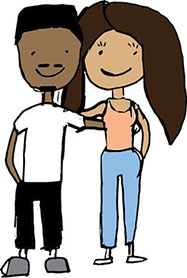


Coming home from the job fair in question, Marc met Linda, a Brazilian beauty who works as a nurse at the health center of his university. Marc was so taken by reading on his smartphone about the concept of Everledger that he had stepped onto the bicycle lane. Linda was just able to brake in time, but they both got quite a fright from the encounter. Marc was a bit embarrassed, but then he dared ask Linda if she wanted to network with him on Facebook. Marc is very proud of this. Now they swap emoticons via Whatsapp nearly every hour. Marc usually sends little diamonds—not as a digital assets but as virtual tokens of affection to his lovely Linda. But he was also fascinated by the fact that diamonds as digital assets change owners through a private blockchain.
Visualization of the team
User profiles of a typical start-up team:

Pains:
- For Marc, his team doesn’t learn quickly enough. He wants to conduct simple experiments and develop prototypes in the service environment more rapidly.
- Marc pursues a lean approach for his start-up and has noticed how important it is to be honest with oneself and that the biggest risks should be tested first.
- The dynamics of the market and the technology are so great that even things that have already been tested ought to be questioned again and again.
- Marc always sees new options in the business ecosystem. It is sometimes hard for him to design a complex ecosystem and to shape the business models for the actors in the system.
Gains:
- Marc is enthusiastic about his subject and his team. He enjoys the energizing atmosphere and meaningful work.
- Marc uses design thinking for innovation exchange and combines it with new elements.
- Marc loves the possibilities of digital business models and knows that the whole world is in upheaval, offering start-ups huge opportunities.
- At this point, Marc has come to love interviews and tests with real users. He has learned to ask the right questions and looks forward to the new findings that are spewed forth at a rapid pace.
Jobs-to-be-done:
- Marc wants a book that gives leeway to his natural talent for questioning what exists, presents him with new tools, and shows him how they’re applied.
- He wants to know how he can transform his knowledge of information technologies into meaningful solutions. It’s vital to him that he find a scalable solution for his blockchain idea quickly and that an innovative business model makes the enterprise viable in the medium term.
- He wishes to work in an environment in which the concept of “teams of teams” is a lived reality, and would like to get suggestions for it.
- With the aid of design thinking, Marc wants to establish a common language and mindset. The dynamics, complexity, and uncertainty are rising. Marc can deal with the situation pretty well, but he has noted that his team is not so good at it.
- Particularly in the blockchain environment, technological development is proceeding quite rapidly. The team must learn from experiments speedily and develop both the market and customers.
There are different ways of creating personas. It is important to imagine the typical user as a “real person.” People have experience, a life career, preferences, and private and professional interests. The primary goal is to find out what their true needs are. Frequently, potential users are sketched out in an initial iteration, which is based on the knowledge of the participants. It must then be verified that a user who has been sketched out like this actually exists in the real world. Interviews and observations often show that potential users have different needs and preferences than those originally assumed. Without exploring these deeper insights, we never would have found out that Peter likes red underpants and Lilly has a tic with flip-flops.
In many workshops, so-called canvas models are used in the context of strategy work and the generation of business models and business ecosystems associated with it. We developed a “user profile canvas” for our workshops that helps in having the key questions at hand and, based upon them, in creating a persona expeditiously.
To promote the creativity of participants and encourage out-of-the-box thinking, it is useful to cut the canvas apart and glue it onto a huge poster. On this poster, the persona can be drawn in full size.
In so doing, it is worthwhile to improve the persona iteratively, refining it and digging deeper step by step.
It always makes sense to ask for the “why” in order to get to the actual problem. We try to find out about real situations and real events so as to find stories and document them. Photos, images, quotes, stories, etc., help to make the persona come alive.
In general, work with the persona concept is reminiscent of the procedure applied by so-called profilers (case analysts) in American detective TV series. Profilers are on the hunt for the perpetrators. They solve murders and reconstruct the course of events. They work by describing relevant personality and character traits in order to draw conclusions from behavior.
We recommend taking the time to create a persona yourself. The intensity and closeness are important for building up empathy with the potential user. If time is short, standard personas can be used.
You must be cautious when it comes to personas with brief descriptions. The example of the “persona twins” shows why. Although the core elements are the same, the potential users couldn’t be more different. This is why it really makes sense to dig one level deeper to understand the needs in greater detail. We get greater insights, and that makes things even more intriguing.
Persona twins
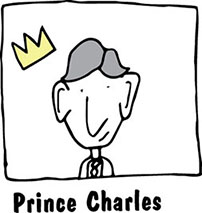
Born in 1948
Grew up in England
Married twice
Has children
Successful, rich
Takes vacations in the Alps
Likes dogs
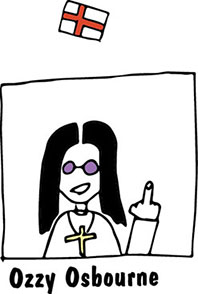
Born in 1948
Grew up in England
Married twice
Has children
Successful, rich
Takes vacations in the Alps
Likes dogs

The initial draft of a persona is quickly done. Although just an outline exists, it can be quite helpful and eye-opening. A brainstorming on the team can yield initial insights and contribute to a better understanding; it is absolutely necessary, though, that it be underpinned with real people, observations, and interviews.
In a first step, the user must be defined and found. Ideally, we’ll go outside right at the beginning and meet a potential user. We observe him, listen to him, and build up empathy. The insights are well documented, in the best case using photos and videos. If you take pictures, it is important to ask permission beforehand, because not everybody likes to be photographed or filmed! A so-called empathy card can be used here that addresses the following areas: hearing, thinking and feeling, seeing, speaking and doing, frustration, and desire.
We also suggest speaking to experts who know the persona well and, of course, being active yourself and doing what the user is doing.
The credo is: “Walk in the shoes of a potential user!”
Especially when we think we know the products or the situation, we attempt to approach a situation like a beginner—curious and without previous knowledge. Consciously and with all our senses, we go through the experience the user is going through!
After this “adventure,” it is useful to define hypotheses on the team, then test them with a potential user or by using existing data, then confirm, discard, or adapt them. The picture of the persona becomes clearer and more solid with each iteration.

To obtain initial knowledge on the user, another tool that helps is the AEIOU method. AEIOU helps us to capture all the events in our environment.
The task is clear. Get out of the design thinking rooms and speak to potential users, walk in their shoes, do what they do.
The AEIOU questions help to put some structure into the observations. Especially with inexperienced groups, it is easier this way to ensure an efficient briefing on the task at hand.
Depending on the situation, it is useful to adapt the questions individually to the respective observations. The AEIOU catalog of questions and the associated instructions help participants establish contact with initial potential users. Experience has taught us that it helps the groups if a design thinking facilitator or somebody with needfinding experience accompanies first contact of potential users. We all are pretty inhibited when it comes to addressing strangers, observing them, and asking them about their needs. Once the first hurdle has been cleared, some participants and groups develop into true needfinding experts. Chapter 1.4 will deal in greater detail with needfinding and the creation of question maps.
AEIOU is broken down into five categories.
Consider how each of the users behaves in the real world and the digital world.
Activities |
What happens? What are the people doing? What is their task? What activities do they carry out? What happens before and after? |
Environment |
What does the environment look like? What is the nature and function of the space? |
Interaction |
How do the systems interact with one another? Are there any interfaces? How do the users interact among one another? What constitutes the operation? |
Objects |
What objects and devices are used? Who uses the objects and in which environment? |
User |
Who are the users? What role do the users play? Who influences them? |
The hook framework (Alex Cowan) is based on the idea that a digital service or a product can become a habit for a user. The hook canvas is based on four main components: trigger for an action, activity, reward, and investment. For the potential user, there are two triggers for his actions: triggers from the external environment (e.g., a notification from Tinder that you received a “Super Like”) or internal triggers for an action (e.g., visiting the Facebook app when you feel lonely).
The action describes the minimum interaction of your service or your product with a potential user. As a good designer, you want to design an action to be as simple and fast as possible for the user.
Reward is the key emotional element for the user. Depending on the configuration of the action, the user can be given a lot more than the satisfaction of the initial need. Think of positive reviews and feedback through a comment or article. You just wanted to share the information, but you get back far more due to the reputation of the community.
The question remains as to what the user invests in order to get himself back in the loop and to trigger an internal or external action. For example, he actively follows a Twitter feed or writes a notification that a certain product or service is available again.

The jobs-to-be-done framework became widely known through the milkshake example. The problem statement looks familiar to us: How can the sales of milkshakes be increased by 15%? With a conventional mindset, you would look at the properties of the product and then consider whether a different topping, another flavor, or a different cup size might solve the problem. Through a customer survey, you find out that the new properties are popular. However, in the end, only incremental innovations are realized, and the result has only been marginally improved. The jobs-to-be-done framework focuses instead on a change of behavior and on customer needs. In the case of the milkshake, it was found this way that two types of customers buy milkshakes in a fast food restaurant. The point of departure was: Why do customers buy a product? To put it differently: What product would they buy instead of the well-known milkshake?
The result:
The first type of customer comes in the morning, commutes to work by car, and buys a milkshake as a substitute for breakfast and as a diversion while driving. Coffee doesn’t work because it is first too hot and then too cold. It is also liquid and can spill easily. The ideal milkshake is large, nutritious, and thick. So the jobs-to-be-done of the milkshake are therefore a breakfast substitute and a pleasant diversion while driving to work.
The second type of customer comes in the afternoon, usually, a mother with a child. The child wants something to eat in the fast food restaurant and is whining. The mother wants to get something healthy for the child and buys a milkshake. The milkshake should be small, thin, and liquid, so the child can drink it quickly, and it should be low in calories. The milkshake’s jobs-to-be-done are to satisfy the child and make the mother feel good. In principle, for any product, whether digital or physical, you can ask: Why would a customer buy my product or service?

Innovations like those designed by Adobe Photoshop and Instagram are good examples of jobs-to-be-done in the digital environment. Both solutions aim at making photographs look like those taken by pros. Photoshop offers easy professional editing of pictures through an app. Instagram realized early on that pictures can be easily edited and shared via social media.
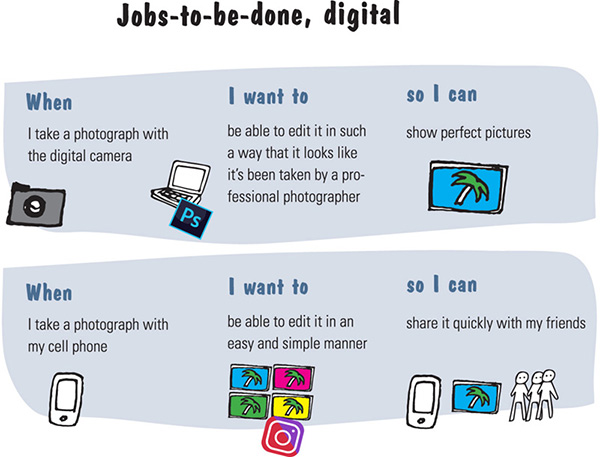
Because human beings always take center stage in design thinking and the persona to be created is very important, we sketched out the approach once more by way of example. When teams are tasked with developing “empathy” with a user over a certain period of time, or when they first apply design thinking, it is useful to specify a structure and the steps to be taken. Depending on the situation, we recommend using the tools just described (AEIOU, jobs-to-be-done framework, hook canvas, user profile canvas) or integrating and using other methods and documents into the steps listed here.
To help you better understand this process, the Playbook is interspersed with various “How might we . . .” procedures.
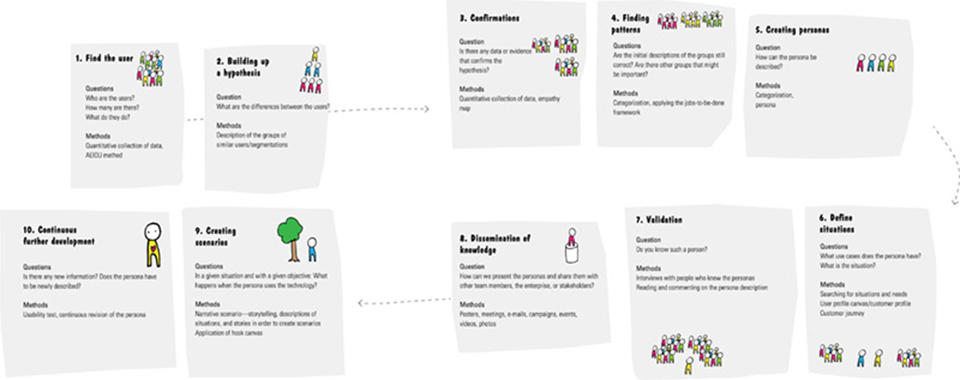
Especially in radical innovation projects, the time horizon is often far longer. It may take 10 years before a product is launched on the market, for example. If its target group is 30 to 40 years old, this means that these users now are 20 to 30 years old.
The future user method attempts to extrapolate these users’ future personas (see “Playbook for Strategic Foresight and Innovation”). It expands the classic persona by analyzing today’s persona and its development over the last few years. In addition, the future target group is interviewed at their present age. Subsequently, the mindset, motivation, lifestyle, etc. are extrapolated to get a better idea of the future user.

The method is easy to apply. It is best to start with the profile of the current user and underpin it with facts, market analyses, online surveys, personal interviews, and so forth.
When developing the persona, changes in values, lifestyle, use of technologies/media, product habits, and the like, must be borne in mind.